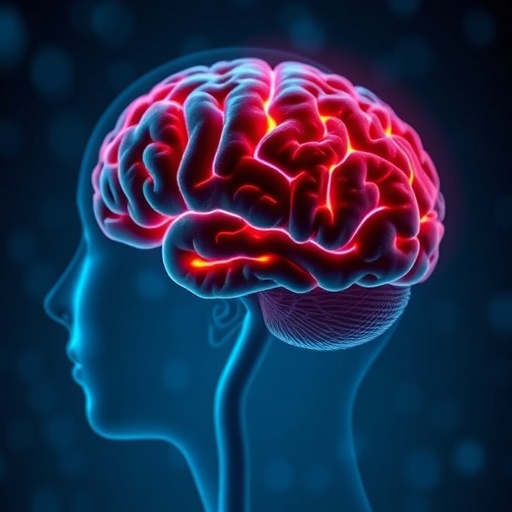In a groundbreaking study slated for publication in BMC Psychology, researchers have unveiled critical insights into the complex interplay between family dynamics and adolescent internet addiction, particularly focusing on those suffering from Internet Gaming Disorder (IGD). Utilizing advanced neuroimaging and psychological assessment techniques, the study identifies the middle frontal gyrus as a pivotal neural gateway influencing how familial relationships impact addictive behaviors in teenagers who excessively engage in internet gaming.
Internet Gaming Disorder has emerged as a growing concern worldwide, with the World Health Organization recognizing it as a mental health condition requiring attention. Despite its global relevance, the neurological mechanisms linking familial factors and gaming addiction have remained elusive. Zhang, Li, Zhang, and colleagues offer a novel perspective by localizing this interaction within the middle frontal gyrus, a region renowned for its roles in executive function, decision-making, and impulse control.
The study employed a cross-sectional design involving adolescent participants diagnosed with IGD. Using functional magnetic resonance imaging (fMRI), the team assessed the brain activity of these individuals alongside comprehensive evaluations of their family relationships, covering emotional support, communication patterns, and conflict levels. The researchers then mapped these psychosocial variables onto neural activity patterns to decipher how family environment exerts influence on brain functions related to addiction.
Findings revealed significant correlations between weakened family bonds and altered neural activation in the middle frontal gyrus. Specifically, adolescents reporting poor familial support showed diminished activity in this brain region during tasks requiring self-regulation and inhibitory control. This neural hypoactivity suggests a mechanistic pathway through which adverse family relationships may enhance vulnerability to compulsive gaming behaviors.
The middle frontal gyrus’s role as a neural mediator underscores its integral part in moderating the psychological impact of family interactions. Given its involvement in integrating emotional and cognitive processes, disruptions in this area’s functioning could destabilize an adolescent’s ability to regulate gaming urges effectively, tipping the balance toward addictive patterns. This discovery bridges a critical gap in understanding the biopsychosocial etiology of internet addiction.
Furthermore, the research emphasizes the bidirectional nature of these interactions. While dysfunctional family environments can impair middle frontal gyrus activity, excessive gaming itself may exacerbate neural dysregulation, creating a feedback loop that entrenches addictive behavior. Recognizing this cyclical dimension opens new avenues for therapeutic interventions targeting both psychosocial and neurological components.
Importantly, the study controlled for confounding variables such as age, gender, and socioeconomic status, ensuring that the observed neural alterations were specifically attributable to family relational factors rather than extraneous influences. This methodological rigor bolsters confidence in the results’ validity and their implications for precision medicine in behavioral addictions.
From a clinical perspective, these findings highlight the necessity of incorporating familial assessments and relationship-building strategies into treatment plans for adolescent IGD patients. Therapies designed to enhance family cohesion and communication could indirectly normalize middle frontal gyrus activity, improving self-regulation capacities and reducing addictive tendencies.
This research also adds to the growing body of evidence linking prefrontal cortex functionalities with behavioral control deficits in addiction. Prior studies have identified frontal lobe impairments in substance use disorders; by extending this link to behavioral addictions such as IGD, the current investigation broadens our neurobiological understanding of compulsivity beyond chemical dependencies.
Moreover, the study’s reliance on neuroimaging provides an objective biomarker for monitoring treatment efficacy. Changes in middle frontal gyrus activation could serve as quantifiable endpoints to evaluate how interventions impact the brain’s regulatory networks, facilitating more adaptive, neuroscience-informed therapeutic approaches.
The cross-sectional nature of the investigation does impose limitations; causal inferences remain tentative, and longitudinal research is warranted to track how family relationships and frontal gyrus activity evolve over time in relation to gaming behaviors. Future studies might also explore whether these findings generalize to other forms of internet addiction or behavioral compulsions.
Nevertheless, the identification of a neural mediator underscores the intricate biopsychosocial framework that underpins IGD, moving beyond simplistic cause-and-effect models. It reinforces the notion that adolescent internet addiction is not merely a matter of individual choice but is deeply embedded in the social and neurobiological contexts surrounding the young person.
The work by Zhang et al. opens exciting possibilities for interdisciplinary collaboration. Neuroscientists, psychologists, and family therapists can converge to develop targeted interventions enriched by neural insights, aiming to disrupt maladaptive patterns before they crystallize into chronic disorders.
Furthermore, this study resonates with broader public health strategies aiming to mitigate adolescent mental health risks associated with digital media exposure. By pinpointing specific brain regions implicated in addiction vulnerability, policymakers can better understand the neurological stakes of unregulated or unhealthy internet use.
Intriguingly, the middle frontal gyrus, previously underexplored in the context of family dynamics and internet addiction, now emerges as a critical neural node. Its proper functioning appears essential for buffering adolescents against the addictive allure of online gaming by fostering resilience anchored in healthy social connections.
Efforts to reinforce family environments, alongside interventions designed to enhance frontal lobe functionality, could form a dual-pronged approach to curb the surge of internet gaming disorder worldwide. Such strategies might encompass parental education programs, cognitive training exercises, and neurofeedback technologies aimed at optimizing frontal cortical activity.
In conclusion, the study elucidates how the middle frontal gyrus serves as an essential mediator linking adolescent family relationships with the risk of internet gaming addiction. By integrating neurobiological evidence with psychosocial context, this research advances our comprehension of complex behavioral disorders and paves the way for innovative, multidimensional treatment paradigms addressing the root causes of internet gaming disorder.
Subject of Research: Neural mechanisms mediating the relationship between family dynamics and internet addiction in adolescents with Internet Gaming Disorder.
Article Title: The middle frontal gyrus as a neural mediator between family relationships and internet addiction among adolescents with internet gaming disorder: a cross-sectional study.
Article References: Zhang, Y., Li, Y., Zhang, H. et al. The middle frontal gyrus as a neural mediator between family relationships and internet addiction among adolescents with internet gaming disorder: a cross-sectional study. BMC Psychol 13, 1263 (2025). https://doi.org/10.1186/s40359-025-03611-1
Image Credits: AI Generated




